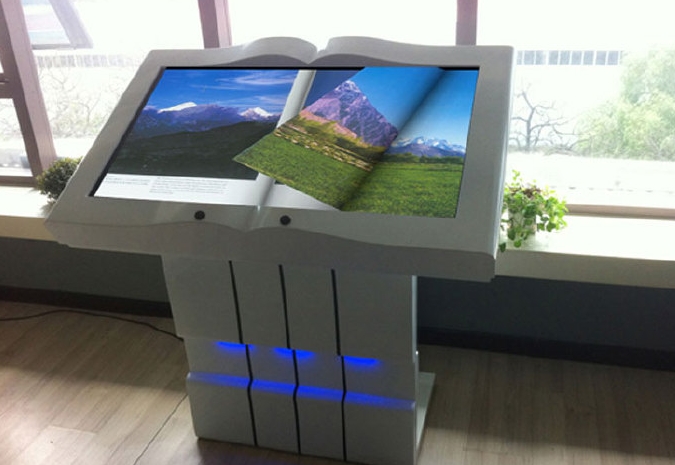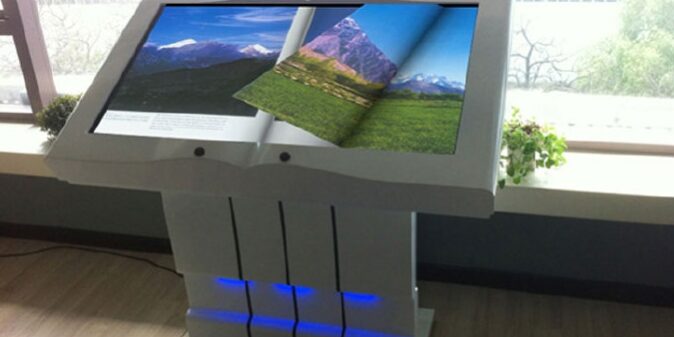The rapid advancement of digital technology has transformed content exhibition and display into increasingly digitized and interactive domains. Among these innovations, traditional book reading experiences have evolved through the fusion of multimedia technology and interactive design, giving birth to the groundbreaking Interactive Projection Book display method. This innovative solution preserves books’ classic form as cultural carriers while dramatically enhancing visitor experiences through the combination of projection technology and physical book models.

Understanding Interactive Projection Book Technology
The Physical Flipbook Edition represents a sophisticated electronic book system that utilizes camera-based graphic recognition algorithms to identify page numbers and control projectors to display corresponding content onto white physical book pages. This creates an authentic book-flipping experience that bridges traditional reading with cutting-edge technology.
Core System Components
Modern interactive book systems integrate several essential technological elements:
- High-resolution cameras for precise page detection
- Advanced projection mapping technology
- Real-time content management systems
- Audio integration for enhanced storytelling
- Durable physical book models designed for continuous use
Key Features and Functionality
Advanced Page Recognition
The system employs sophisticated graphic recognition algorithms that instantly identify the current page position when visitors flip through the physical book model. This seamless integration ensures:
- Real-time content synchronization between physical movement and digital display
- Accurate page tracking regardless of flipping speed
- Consistent performance across extended operational periods
Multimedia Content Integration
Enhanced digital capabilities allow for rich content presentation including:
- High-definition images and graphics
- Embedded video content for dynamic storytelling
- Interactive animations that respond to page changes
- Multi-language support for diverse audiences
Audio Enhancement Features
Each page supports comprehensive audio functionality:
- Narrated content for accessibility and engagement
- Background soundscapes to enhance atmosphere
- Multiple language options for international visitors
- Volume control for different exhibition environments
Distinctive Advantages
Immersive Reading Experience
The fusion of realistic physical book models with rich multimedia content creates unprecedented immersive reading environments. Visitors experience the tactile satisfaction of turning real pages while accessing a magical knowledge universe that transcends traditional reading limitations.
Flexible Content Customization
Dynamic content management capabilities enable:
- Real-time content updates without system downtime
- Theme-specific customization for different exhibitions
- Seasonal content rotation to maintain visitor interest
- Personalized experiences based on audience demographics
Low Maintenance Requirements
Modular system design significantly reduces operational complexity:
- Simplified installation processes minimize setup time
- Remote monitoring capabilities enable proactive maintenance
- Intelligent diagnostic systems quickly identify and resolve issues
- Cost-effective operation through efficient resource utilization
Primary Application Scenarios
Exhibition and Display Venues
In museums, science centers, and corporate showrooms, Interactive Projection Book systems serve as compelling information display centerpieces. These installations attract visitors to actively explore content while presenting:
- Historical timelines through engaging visual narratives
- Product demonstrations with interactive explanations
- Research achievements in accessible, entertaining formats
- Corporate heritage stories that build brand connection
Educational and Science Communication
Educational exhibition halls benefit tremendously from physical flipbook technology. The realistic book appearance naturally draws audiences who can flip through physical models to access:
- Scientific concepts explained through visual demonstrations
- Educational curricula enhanced with multimedia elements
- Interactive learning modules that adapt to different learning styles
- Assessment tools that track visitor engagement and comprehension
Cultural Heritage Preservation
In libraries, bookstores, and cultural heritage sites, these systems recreate precious historical documents including:
- Ancient manuscripts with high-resolution digital preservation
- Local historical records that tell community stories
- Family genealogies that connect visitors with heritage
- Rare book collections previously inaccessible to general public
Technical Specifications and Performance
Hardware Requirements
Professional-grade equipment ensures reliable operation:
- Industrial cameras with advanced image processing capabilities
- High-brightness projectors suitable for various lighting conditions
- Robust book models designed for continuous visitor interaction
- Centralized control systems for seamless operation management
Software Capabilities
Sophisticated software platforms provide comprehensive functionality:
- Content management systems for easy updates and modifications
- Analytics dashboards tracking visitor engagement patterns
- Multi-device synchronization for coordinated exhibitions
- Security protocols protecting sensitive cultural content
Future Development Trends
Artificial Intelligence Integration
AI-powered enhancements will revolutionize interactive book experiences through:
- Personalized content recommendations based on visitor behavior
- Natural language processing for voice-activated navigation
- Predictive maintenance algorithms reducing downtime
- Adaptive content delivery optimized for individual learning preferences
Enhanced Interactivity Features
Next-generation systems will incorporate:
- Gesture recognition technology for touchless interaction
- Augmented reality overlays expanding content possibilities
- Collaborative features enabling multiple simultaneous users
- Social sharing capabilities connecting physical and digital experiences
Sustainability Considerations
Environmentally conscious design focuses on:
- Energy-efficient components reducing operational costs
- Sustainable materials in physical construction
- Longevity optimization extending equipment lifecycles
- Recycling programs for end-of-life components
Implementation Best Practices
Planning and Design Phase
Successful installations require careful consideration of:
- Audience demographics and interaction preferences
- Content strategy aligned with exhibition objectives
- Physical space requirements and environmental factors
- Budget allocation for equipment, installation, and maintenance
Installation and Setup
Professional installation ensures optimal performance through:
- Precise calibration of projection and recognition systems
- Content testing across all interactive elements
- Staff training for operation and basic troubleshooting
- Visitor orientation materials and signage
Ongoing Optimization
Continuous improvement strategies include:
- Regular content updates maintaining visitor interest
- Performance monitoring identifying optimization opportunities
- Visitor feedback collection guiding future enhancements
- Technology upgrades incorporating latest innovations
Measuring Success and ROI
Quantitative Metrics
Performance indicators demonstrate system effectiveness:
- Visitor engagement duration compared to traditional displays
- Content interaction rates across different pages and sections
- Return visitor statistics indicating lasting appeal
- Operational efficiency measurements and cost analyses
Qualitative Assessment
Visitor experience evaluation encompasses:
- Satisfaction surveys measuring engagement quality
- Educational impact assessment for learning-focused applications
- Cultural connection strength in heritage preservation contexts
- Brand enhancement effects for corporate installations
The Interactive Projection Book system represents a significant advancement in exhibition technology, offering unprecedented opportunities to engage audiences while preserving the fundamental appeal of traditional books. As technology continues evolving, these systems will undoubtedly become increasingly sophisticated, providing even more compelling and educational experiences that bridge the gap between physical and digital worlds.
Through thoughtful implementation and ongoing optimization, organizations can leverage this innovative technology to create memorable, educational, and culturally significant experiences that resonate with visitors long after their initial encounter.







